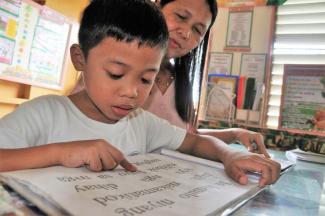<p>August 2018 — John*, 7, lives in Ubay, Bohol — a small town in the central region of the Philippines. He runs his finger through the pages of a book, sounding out words about a small hut and vegetable garden.</p>
<p>Last year, John could not read the alphabet. Worried that he might have a learning disability, John’s mother, Chesa*, nearly pulled him out of first grade to retake kindergarten. But John’s teacher, Ruffa Maboloc, persuaded Chesa to let John stay in her class because he was clearly committed to learn.</p>
<p>“He chose books from our reading corner and looked at the pictures,” said Mabaloc, noting his interest in books.</p>
<p>Aside from John, five other students in the class struggled to read. To better address their learning needs, Mabaloc grouped them together during class reading time. While her more advanced students read on their own, she helped John and his classmates sound out letters individually to form words.</p>
<p>Maboloc learned these techniques as part of her literacy training from USAID’s early grade reading project, Basa Pilipinas (Read Philippines). From 2013 to 2018, USAID partnered with the Philippine Department of Education to support the country’s goal of improving the reading skills of early grade students. Implemented by Education Development Center, the Basa project trained school administrators and teachers like Mabaloc to effectively improve students’ literacy. The project also produced learning materials for classrooms.</p>
<p>“For years, I relied on memorization and drills. Most of my students did not progress in their reading and continue to struggle in the higher grades,” said Mabaloc, adding that this teaching style is typical in Philippine classrooms.</p>
<p>Through USAID’s Basa project, Maboloc learned new ways to help her students master the sound of each letter of the alphabet. From that, she built upon their ability to read out loud, expanded their vocabulary, and strengthened comprehension skills using children’s books.</p>
<p>She established a reading corner with USAID-provided books. Students began choosing colorful storybooks with varying degrees of difficulty. The books are written in Filipino and Sinugbuanong Binisaya, the mother tongue languages of students in her classroom. Studies show that mastering basic literacy in a child’s mother tongue helps them transition to more advanced learning in mainstream languages.</p>
<p>“The reading corner is a big hit! I change the books every couple of weeks so that the students have new material to explore,” says Maboloc. This nurtures their love of reading.</p>
<p>John is now in the second grade. He can read, write, speak and comprehend in Filipino and Sinugbuanong Binisaya. “Learning to read has given him more confidence,” says his mother.</p>
<p>USAID’s Basa Pilipinas project, which ran from 2013 to 2018, strengthened the reading skills of more than 1.8 million students from kindergarten to the third grade, trained over 19,000 teachers and school administrators, and provided nearly 10.5 million copies of teacher guides, storybooks and other education aids to 3,000 public elementary schools in the Philippines.</p>
<p>“Seeing my students develop into readers brings me so much joy,” said Maboloc.</p>
<p><em>*Full name withheld to protect identity</em>.</p>
<p><strong>LINKS</strong></p>
<div class="wysiwyg-style-related-link"><strong><a href="http://www.usaid.gov/philippines">USAID’s mission in the Philippines</a></strong></div>
<p>Follow <a href="https://twitter.com/USAID_Manila" target="_blank"><strong>@USAID_Manila</strong></a>, on <a href="https://www.facebook.com/usaid.philippines" target="_blank"><strong>Facebook</strong></a>, on <a href="https://www.flickr.com/photos/rpusaid/" target="_blank"><strong>Flickr</strong></a>, on <strong><a href="https://www.youtube.com/user/USAIDPhilippines">YouTube</a></strong></p&…;
,“Seeing my students develop into readers brings me so much joy.”

Karen Rivera for USAID
